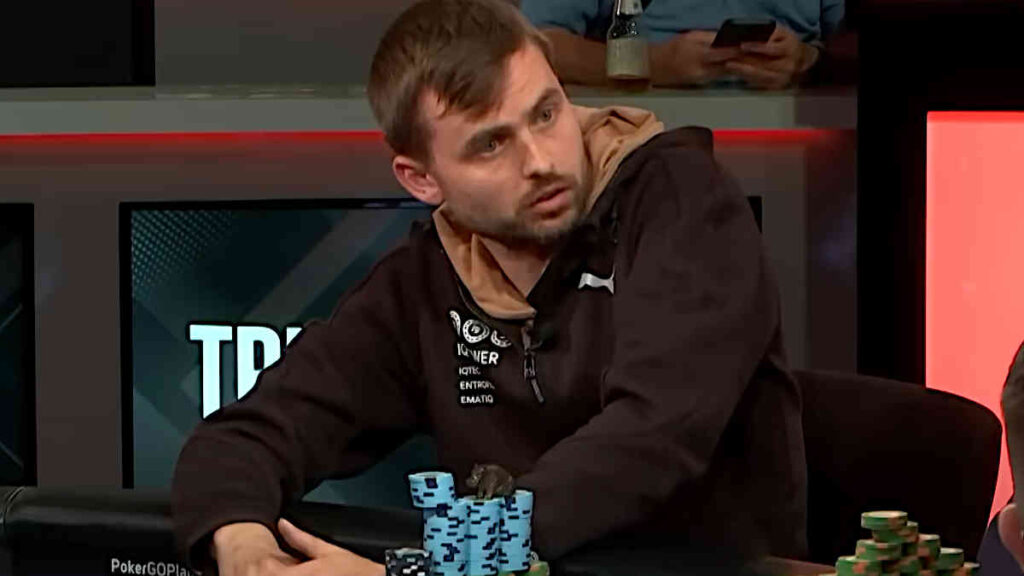Players taking way too much time to act in live poker tournaments has been a point of controversy for some time now. In addition to making the action painful to watch for the fans, it’s straight-up annoying for the non-tanking players who just want to play the game.
Despite all the negative press tanking in poker has been getting lately, there are some players who don’t care about what others think, and they certainly don’t mind annoying their opponents. In fact, for Martin Kabrhel’s of this world, it’s a part of their game plan.
Kabrhel’s table antics have already earned him the title of a poker villain, but this seems to only inspire him to try and push boundaries even further.
The latest such attempt at pushing boundaries happened at the World Series of Poker, where Martin managed to upset everyone at his table in the $5,000 PLO event by taking forever to act on every single hand. Eventually, things got so bad that the tournament director had to get involved and put Kabrhel on a 10-second time limit.
Pushing the Envelope
If you are a poker fan, you’ve probably heard of Martin Kabrhel. Czech poker pro is a verifiable crusher at the tables, with over $14,000,000 in live tournament winnings. Yet, it is rarely his results that get Kabrhel in the spotlight.
The high-stakes pro has reached an unprecedented level of notoriety in the community, with very few of his fellow players having anything good to say about him.
Excessive tanking, never-ending table talk, and deliberately mixing his chips so that his stack is hard to evaluate properly are just a small part of his usual table antics, so it is no surprise that he’s not a very popular character.
Kabrhel’s entire approach to poker seems to be one of balancing on the very edge of rules. He will come as close to the line as possible without crossing it, looking to gain an edge over his opponents by either confusing them into doing a wrong thing or tilting them out of their minds.
A few days ago, Martin was back at it in the $5,000 PLO event. As the tournament dwindled down to the last two tables, Kabrhel turned up his tanking mode to the max, taking forever for every preflop decision.
It’s gotten so bad that players started to call a clock on him every hand, but this didn’t do much, as even with that, he’d have 60 seconds to act. Eventually, the tournament director stepped up to the plate and issued the Czech pro with a mandatory shot clock, giving him only 10 seconds to act on his hands before the flop.
Kabrhel, used to his villain role, wasn’t too bothered. He adjusted to the new situation and continued to look for other ways to tilt his opponents. Eventually, he busted in third place, pocketing close to $290,000.
Hardly anyone was shocked to see Martin doing his thing once again. However, the whole incident reignited the debate about tanking in poker and what (if anything) could be done about players who purposefully abuse the rules while staying careful not to break them.
Going Around in Circles
While putting together this article, we reached out to Matt Savage, the man whom the entire poker community recognizes as the ultimate authority on all types of poker tournament issues.
Commenting on the tanking situation in general, Savage shared:
It’s up to the organizers and the TD to first make a decision on whether they want to institute a clock prior to the start of the tournament. I really wish it wasn’t needed, but here we are discussing it once again, unfortunately.
If there are no clocks in play, then the TD has to reduce the amount of time the player has to act whether or not another player has called the clock.
The World Series of Poker doesn’t use shot clocks. There are probably a couple of reasons for this. The biggest one is probably of a logistical nature, as there are so many tables happening at the same time.
The second reason is probably a much bigger factor, though. The WSOP attracts players of all shapes and sizes. Not everyone visiting Las Vegas during summer is a consummate professional with hundreds of tournaments under their belts.
For recreational players, a mandatory shot clock could be scary and confusing, to the point where it deters at least some percentage from playing.
Finally, even this solution doesn’t address the problem fully. If players are given a reasonable amount of time to act, say 30 seconds, someone could still use their entire clock on every single hand, significantly slowing down the action.
So, as Savage points out, we seem to be circling back to the same problem over and over again. With that in mind, perhaps it’s time for the poker community to take a more hardline approach.
Reaching the Breaking Point
The poker world is a colorful one. It consists of professional players, enthusiastic fans of the game, and people who enjoy an occasional poker tournament as a special treat. Regardless of where anyone falls in this hierarchy, everyone deserves to have a good experience, especially at the WSOP.
As someone who’s seen a lot of shenanigans during his long career, Savage minces no words when it comes to players who ruin it for everyone else:
Once a player is deemed to be abusing a fair amount of time to act, I believe penalties (should be introduced) and even lead to disqualification if penalties and time reduction are not working. The floor should not have to babysit a player who is abusing time and ruining the experience for everyone else.
And it’s really hard to argue against this statement!
Maybe it’s time for the poker community to start taking a firmer approach against repeat offenders who constantly get away on “technicalities.” While some behaviors may not be breaking the rules of the game, they most certainly aren’t in the spirit of the game, and that should count for something.
Until that happens, some players will continue to abuse the system to their benefit, which may work for them personally, but it certainly doesn’t help the overall poker image.
It’s hard to say what the exact solution is, but maybe we could start by giving tournament directors more power in these issues, allowing them to institute harsher penalties sooner. It may not be perfect, but it should at least start moving the needle in the right direction.


